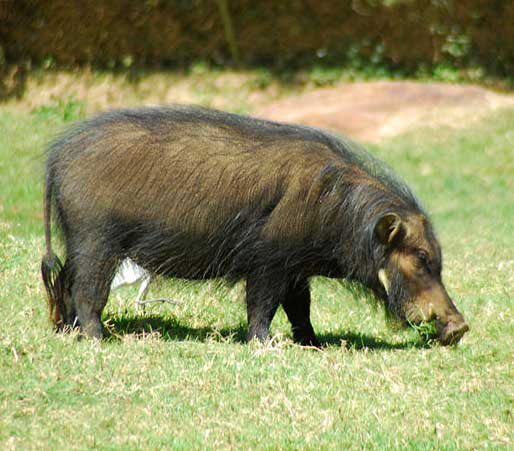Hylochoerus meinertzhageni (*) Cladus: Eukaryota Name Hylochoerus meinertzhageni Thomas, 1904 References * Hylochoerus meinertzhageni in Mammal Species of the World.
The Giant Forest Hog (Hylochoerus meinertzhageni – the only member of its genus), is native to wooded habitats in Africa and generally is considered the largest wild member of the Suidae (pig family; a few subspecies of the wild boar can reach an even larger size). Despite its large size and relatively wide distribution, it was only described by scientists in 1904. The species name honours Richard Meinertzhagen, who shot the type specimen in Kenya and had it shipped to the Natural History Museum in England.[2]
Males reach up 2.1 metres (6.9 ft) in length and 1.1 metres (3.6 ft) in height, and may weigh as much as 275 kilograms (610 lb).[3][4] Females are smaller than males, and the eastern nominate subspecies is larger than H. m. rimator of central Africa and H. m. ivoriensis of west Africa.[3] The giant forest hog has extensive hairs on its body, though these tend to become less pronounced as the animal ages. It is mostly black in colour on the surface, though hairs nearest the skin of the animal are a deep orange colour. Its ears are large and pointy, and the tusks are proportionally smaller than those of the warthogs but bigger than those of the bushpig. Nevertheless, the tusks of a male may reach a length of 35 centimetres (14 in).[5] Distribution Giant forest hogs occur in west and central Africa, where largely restricted to the Guinean and Congolian forests. They also occur more locally in humid highlands of the Rwenzori Mountains and as far east as Mount Kenya and the Ethiopian Highlands. They are mainly found in forest-grassland mosaics, but can also be seen in wooded savanna and subalpine habitats at altitudes up to 3,800 metres (12,500 ft).[4] They are unable to cope with low humidity or prolonged exposure to the sun, resulting in them being absent from arid regions and habitats devoid of dense cover.[4] Habits The giant forest hog is mainly a herbivore, but also scavenges.[6] It is usually considered nocturnal, but in cold periods it is more commonly seen during daylight hours, and it has been suggested it is diurnal in regions where protected from humans.[3] They live in herds (sounders) of up to twenty animals consisting of females and their offspring, but usually also including a single old male.[3] Females leave the sounder before giving birth and returns with the piglets about a week after the birth. All members of the sounder protect the piglets and they can nurse from all females.[5] As all suids of sub-Saharan Africa, the giant forest hog has not been domesticated, but it is easily tamed and has been considered to have potential for domestication.[3] However, in the wild the giant forest hog is more feared than the two Potamochoerus, as males sometimes attack without warning, possibly to protect their sounder.[3] It has also been known to drive spotted hyenas away from carcasses and fights among males resulting in the death of one of the participants are not uncommon.[5] References 1. ^ d'Huart, J.P. & Klingel, H. (2008). Hylochoerus meinertzhageni. In: IUCN 2008. IUCN Red List of Threatened Species. Downloaded on 5 April 2009. Database entry includes a brief justification of why this species is of least concern. Source: Wikipedia, Wikispecies: All text is available under the terms of the GNU Free Documentation License |
|


